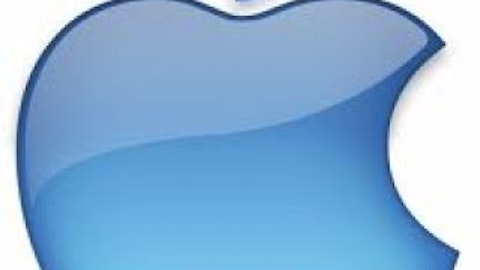
Apple’s premium product strategy
Jobs’ vision for Apple Inc. (NASDAQ:AAPL) was always to create a premier product and charge a premium price. The problem with this strategy occurs when the market becomes fragmented and extremely competitive. In this environment, the difference between a product that is considered great versus one that is good, versus one that is good enough becomes difficult to ascertain.
Though an item might be thought to be superior, its premium price can put off a significant portion of the buying public that will then settle for a good enough alternative at a more reasonable price. Thus, the premium provider has great difficulty in growing or even maintaining market share.
It looks like Apple Inc. (NASDAQ:AAPL) may be facing such a circumstance with its crucial iPhone product. When it first hit the market, Jobs negotiated extremely hard for premium pricing via subsidies from wireless carriers, even offering a short-term exclusive deal to maximize the phone’s value. The result was a generous subsidy that ensured Apple Inc. (NASDAQ:AAPL) receives an exceptionally high selling price.
The current subsidy, estimated at around $300 per phone, helps the company book about $600 of revenue for each phone compared to around $250 for Nokia Corporation (ADR) (NYSE:NOK)‘s smartphone offerings and a similar amount for the recently released Research In Motion Ltd (NASDAQ:BBRY)‘s Z10.
The company’s tough choice
As the mobile phone market increasingly offers more quality phones at a range of price points, Apple Inc. (NASDAQ:AAPL) now faces a difficult choice. Does it try to remain a premium product-premium price company, or does it dive into the commoditized lower priced arena?
Neither choice is very appealing. As a premium player, it probably relegates itself to limited volume growth but a potentially more secure and profitable niche in the market. As a commodity player, the future could be less assured. History indicates that once a company relinquishes its premium status, the chance of customer defection increases substantially with no guarantee of a corresponding acceptance on the budget end.
This is a likely reason why premium-price companies go to extravagant lengths to defend their brands, and even why Jobs chose to strenuously reject the notion of Apple Inc. (NASDAQ:AAPL) offering cheaper alternatives.
The good news for investors
Though Apple Inc. (NASDAQ:AAPL) does have a tough choice to make, it has some wiggle room. One piece of good news is that Apple’s stock price may have already discounted some of the risk. Based on current results and adjusted for a $100 reduction per iPhone subsidy and a $60 billion share buyback, expected annual revenue looks to be around $171 billion with average cash earnings of $29 billion. Using cash earnings times a market capitalization multiplier calculation, the company currently trades at near a low 12x multiple.
This discounted valuation might not fully reflect the company’s potential, especially in China. That country’s wireless market just seems to be adopting the use of advanced wireless service, which makes Apple Inc. (NASDAQ:AAPL)’s product much more desirable. If the company can choose its future strategy wisely and navigate what is probably the most competitive mobile phone market in the world successfully, it would easily confirm a fair business value nearer to $500 per share based on a more reasonable 14x multiplier.
Other opportunities for investors
Investors who don’t want to deal with the strategic risk facing Apple Inc. (NASDAQ:AAPL) specifically have other ways to play China’s wireless opportunities. Here are a couple:
Taiwan Semiconductor Mfg. Co. Ltd. (NYSE:TSM)
Taiwan Semiconductor Mfg. Co. Ltd. (NYSE:TSM) is the world’s largest dedicated semiconductor foundry company. It manufactures chips for many of the major companies in the wireless industry, and has recently begun work on QUALCOMM, Inc. (NASDAQ:QCOM)‘s Snapdragon processor and ARM Holdings plc (NASDAQ:ARMH)‘ new Cortex-A57. As China increases advanced wireless usage, demand for the company’s products will continue to grow.
The company recently announced revenue of $4.4 billion and net income of $1.33 billion for its latest quarter, with a 25.7% year-over-year increase in revenue and 18.2% increase in net income. Based on these results, annualized sales are expected around $20 billion and cash earnings at $6.5 billion, producing a fair business value of $18 per share at a standard 14x multiplier.
China Mobile Ltd. (NYSE:CHL)
China Mobile Ltd. (NYSE:CHL) is the leading provider of mobile phone services in China with about 726 million customers, or about 65% of the entire mobile population. The company and its competitors are just starting to push out 3G services into the market. China Mobile Ltd. (NYSE:CHL) has grown its 3G customer base to 114 million, a 30% jump from the previous quarter. The company is also investing heavily to further develop its 3G consumer and commercial business, and should benefit from the eventual step toward 4G.
An interesting short-term headwind is the company’s use of the relatively independent TD-SCDMA standard for its network. This means that Apple, as well as other phone makers, have to adapt their design to that standard. So far, Apple has not reached an agreement with China Mobile Ltd. (NYSE:CHL) on offering a compatible phone, but longer-term, it seems likely that a deal will be struck that will benefit both parties.
Conclusion
Steve Jobs demanded that Apple be a premium product-premium price company. The company now has to decide whether it wants to maintain that strategy or change course. Whatever they decide is a risky proposition, which the stock price seems to have rightly discounted. But investors may realize a noticeable benefit if the company chooses well and implements the choice successfully.
The article Apple’s Product Strategy Dilemma originally appeared on Fool.com.
Copyright © 1995 – 2013 The Motley Fool, LLC. All rights reserved. The Motley Fool has a disclosure policy.


